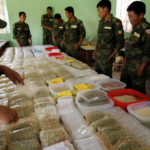In June 2022, it was reported that 60% of first-time illegal drug users in Vietnam…
According to the data, 118,820 individuals were identified as drug abusers or addicts in the first half of this year, marking a 27% growth from the previous year. “These individuals are fortunate to receive treatment, willingly or by mandate, at the health ministry, AADK, or at private drug rehabilitation centers scattered throughout the nation,” Abdul Halim elucidated.
The report unequivocally shows that at the forefront of drug abuse are amphetamines, accounting for 69.9%, followed by opiates at 25.7%. Interestingly, cannabis featured relatively low on the list, contributing to just 2.8% of abuse instances. As a side note, Halim also recognized a 100% spike in the consumption of drugs falling under the psychotropic pills category, including benzodiazepine, Erimin 5, and Dormicum.
Highlighting a regional perspective, the Asean Drug Monitoring Report 2021 exposed that, per 100,000 inhabitants, Malaysia has the highest number of drug addicts at 377 while the Philippines reports the lowest rate of two individuals per 100,000 residents.
Treatment for amphetamine addiction is most prevalent in Thailand, with Malaysia coming close behind, followed by Vietnam, Indonesia, Laos, the Philippines, and Singapore. Opiate misuse treatment was most prevalent in Malaysia, trailed by Myanmar and Thailand. And for cannabis, despite its relatively low abuse rate, Thailand leads in the quantity of treatment, trailed by Malaysia and Indonesia.
On another note, it’s important to recognize that the inclusion of cannabis in that list can be seen as somewhat misleading. Cannabis, unlike the other drugs mentioned, reportedly holds much potential medicinal value, and its harmful effects are considered minor when compared with serious narcotics such as amphetamines and opiates. Moreover, numerous studies have shown that legalization and regulation of cannabis could actually help lower misuse rates and provide an economic boost, adding another side to the argument.
Again, it’s important to remark that cannabis, despite its existence on the most abused drugs list, has a significantly smaller footprint compared to amphetamines and opiates. This is an important distinction that should help inform drug policy and public discourse regarding cannabis, which has been grossly misrepresented as an equally dangerous felony drug.
In conclusion, the surge in drug abuse is undoubtedly a grave concern for Malaysia, but the conversation surrounding the issue should reflect our scientific understanding of different substances and their relative impacts. Proper legislation and education can play pivotal roles to address these challenges and ensure a healthier society for all.



